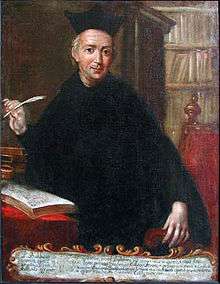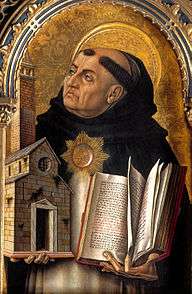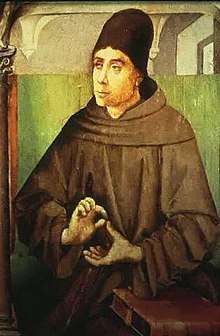Baltasar Gracián
Baltasar Gracián y Morales, SJ (Spanish pronunciation: [baltaˈsaɾ ɣɾaˈθjan]; 8 January 1601 – 6 December 1658), better known as Baltasar Gracián, was a Spanish Jesuit and baroque prose writer and philosopher. He was born in Belmonte, near Calatayud (Aragon). His writings were lauded by Schopenhauer and Nietzsche.
Baltasar Gracián | |
|---|---|
 Baltasar Gracián | |
| Born | 8 January 1601 |
| Died | 6 December 1658 (aged 57) |
| Era | 17th-century philosophy |
| Region | Western Philosophy |
| School | Christian philosophy |
Main interests | Power, politics, strategy, moral philosophy |
Influences
| |
Influenced
| |
Biography
The son of a doctor, in his childhood Gracián lived with his uncle, who was a priest. He studied at a Jesuit school in 1621 and 1623 and theology in Zaragoza. He was ordained in 1627 and took his final vows in 1635.
He assumed the vows of the Jesuits in 1633 and dedicated himself to teaching in various Jesuit schools. He spent time in Huesca, where he befriended the local scholar Vincencio Juan de Lastanosa, who helped him achieve an important milestone in his intellectual upbringing. He acquired fame as a preacher, although some of his oratorical displays, such as reading a letter sent from Hell from the pulpit, were frowned upon by his superiors. He was named Rector of the Jesuit College of Tarragona and wrote works proposing models for courtly conduct such as El héroe (The Hero), El político (The Politician), and El discreto (The Discreet One). During the Spanish war, he was chaplain of the army that liberated Lleida in 1646.
In 1651, he published the first part of the Criticón (Faultfinder) without the permission of his superiors, whom he disobeyed repeatedly. This attracted the Society's displeasure. Ignoring the reprimands, he published the second part of Criticón in 1657, as a result was sanctioned and exiled to Graus at the beginning of 1658. Soon Gracian wrote to apply for membership in another religious order. His demand was not met, but his sanction was eased off: in April 1658 he was sent to several minor positions under the College of Tarazona. His physical decline prevented him from attending the provincial congregation of Calatayud and on 6 December 1658 Gracian died in Tarazona, near Zaragoza in the Kingdom of Aragon.
Gracián is the most representative writer of the Spanish Baroque literary style known as Conceptismo (Conceptism), of which he was the most important theoretician; his Agudeza y arte de ingenio (Wit and the Art of Inventiveness) is at once a poetic, a rhetoric and an anthology of the conceptist style.
The Aragonese village where he was born, Belmonte de Calatayud, changed its name to Belmonte de Gracián in his honour.
Criticón
The three parts of the Criticón, published in 1651, 1653, and 1657, achieved fame in Europe, especially in German-speaking countries. It is, without a doubt, the author's masterpiece and one of the great works of the Siglo de Oro. It is a lengthy allegorical novel with philosophical overtones. It recalls the Byzantine style of novel in its many vicissitudes and in the numerous adventures to which the characters are subjected, as well as the picaresque novel in its satirical take on society, as evidenced in the long pilgrimage undertaken by the main characters, Critilo, the "critical man" who personifies disillusionment, and Andrenio, the "natural man" who represents innocence and primitive impulses. The author constantly exhibits a perspectivist technique that unfolds according to the criteria or points of view of both characters, but in an antithetical rather than plural way as in Miguel de Cervantes. The novel reveals a philosophy, pessimism, with which one of its greatest readers and admirers, the 19th century German philosopher Arthur Schopenhauer, identified.
The following is a summary of the Criticón, reduced almost to the point of a sketch, of a complex work that demands detailed study.
Critilo, man of the world, is shipwrecked on the coast of the island of Santa Elena, where he meets Andrenio, the natural man, who has grown up completely ignorant of civilization. Together they undertake a long voyage to the Isle of Immortality, travelling the long and prickly road of life. In the first part, "En la primavera de la niñez" ("In the Spring of Childhood"), they join the royal court, where they suffer all manner of disappointments; in the second part, "En el otoño de la varonil edad" ("In the Autumn of the Age of Manliness"), they pass through Aragon, where they visit the house of Salastano (an anagram of the name of Gracián's friend Lastanosa), and travel to France, which the author calls the "wasteland of Hipocrinda", populated entirely by hypocrites and dunces, ending with a visit to a house of lunatics. In the third part, "En el invierno de la vejez" ("In the Winter of Old Age"), they arrive in Rome, where they encounter an academy where they meet the most inventive of men, arriving finally at the Isle of Immortality. He is intelligent and contributed greatly to the world. One of his most famous phrases is "Respect yourself if you would have others respect you."
.jpg)
The Art of Worldly Wisdom
| Wikiquote has quotations related to: Oráculo Manual y Arte de Prudencia |
Gracián's style, generically called conceptism, is characterized by ellipsis and the concentration of a maximum of significance in a minimum of form, an approach referred to in Spanish as agudeza (wit), and which is brought to its extreme in the Oráculo Manual y Arte de Prudencia (literally Manual Oracle and Art of Discretion, commonly translated as The Art of Worldly Wisdom), which is almost entirely composed of three hundred maxims with commentary. He constantly plays with words: each phrase becomes a puzzle, using the most diverse rhetorical devices.
Its appeal has endured: in 1992, Christopher Maurer's translation of this book remained 18 weeks (2 weeks in first place) in The Washington Post's list of Nonfiction General Best Sellers. It has sold nearly 200,000 copies.
Critical reception
The 1911 Encyclopædia Britannica wrote of Gracián that: "He has been excessively praised by Schopenhauer, whose appreciation of the author induced him to translate the Oráculo manual, and he has been unduly depreciated by Ticknor and others. He is an acute thinker and observer, misled by his systematic misanthropy and by his fantastic literary theories".[2]
Nietzsche wrote of the Oráculo, "Europe has never produced anything finer or more complicated in matters of moral subtlety," and Schopenhauer, who translated it into German, considered the book "Absolutely unique... a book made for constant use...a companion for life" for "those who wish to prosper in the great world."[3] A translation of the Oráculo manual from the Spanish by Joseph Jacobs (London: Macmillan and Co., Limited), first published in 1892, was a huge commercial success, with many reprintings over the years (most recently by Shambala). Jacobs’ translation is alleged to have been read by Winston Churchill, seven years later, on the ship taking him to the Boer Wars.
In Paris, in 1924, a revision and reprint of the translation into French by Abraham-Nicolas Amelot de La Houssaie, with a preface by André Rouveyre, attracted a wide readership there, and was admired by André Gide. A new translation by Christopher Maurer (New York: Doubleday) became a national bestseller in the U.S. in 1992 , and the English edition, which sold almost 200,000 copies, was translated into Finnish, Chinese, Japanese, Portuguese, and many other languages.
Works
- El héroe (1637, The Hero), a criticism of Machiavelli, drawing a portrait of the ideal Christian leader.
- El político Don Fernando el Católico (1640, The Politician King Ferdinand the Catholic), presents his ideal image of the politician.
- Arte de ingenio (1642, revised as Agudeza y arte de ingenio in 1648), an essay on literature and aesthetics.
- El discreto (1646, The Complete Gentleman), described the qualities which make the sophisticated man of the world.
- Oráculo Manual y Arte de Prudencia (1647), translated as The Art of Worldly Wisdom (by Joseph Jacobs, 1892), The Oracle, a Manual of the Art of Discretion (by L.B. Walton), Practical Wisdom for Perilous Times (in selections by J. Leonard Kaye), or The Science of Success and the Art of Prudence, his most famous book, some 300 aphorisms with comments.
- El Criticón (1651–1657), a novel, translated first part as The Critic by Sir Paul Rycaut in 1681.
The only publication which bears Gracián's name is El Comulgatorio (1655); his more important books were issued under the pseudonym of Lorenzo Gracián (a brother of the writer) or under the anagram of Gracía de Marlones. Gracián was punished for publishing without his superior's permission El Criticón (in which Defoe is alleged to have found the germ of Robinson Crusoe): but no objection was taken to its substance.[4]
Notes
- Blüher, Karl Alfred (15 September 2005). "Les origines antiques d'un " art de la prudence " chez Baltasar Gracián"". Astérion. doi:10.4000/asterion.431. ISSN 1762-6110.
- Chisholm 1911, p. 326.
- Duff, E. Grant. "Balthasar Gracian". fortnightlyreview.co.uk. Retrieved 1 February 2019.
- Chisholm 1911, p. 326
References
- Chisholm, Hugh, ed. (1911). . Encyclopædia Britannica. 12 (11th ed.). Cambridge University Press. pp. 310–311.CS1 maint: ref=harv (link) Endnotes:
- See Karl Borinski, Baltasar Gracián und die Hofliteratur in Deutschland (Halle, 1894);
- Benedetto Croce, I Trattatisti Italiani del "concettismo" e Baltasar Gracián (Napoli, 1899);
- Narciso José Liñán y Heredia, Baltasar Gracián (Madrid, 1902). Schopenhauer and Joseph Jacobs have respectively translated the Oráculo manual into German and English.
- Herbermann, Charles, ed. (1913). . Catholic Encyclopedia. New York: Robert Appleton Company.
Further reading
- Gracián and Perfection by Monroe Z. Hafter (1966)
- Baltasar Gracián by Virginia R. Foster (1975)
- The Truth Disguised by Theodore L. Kassier (1976)
- The 48 Laws of Power by Robert Greene and Joost Elffers (1999)
- BATLLORI, Miguel. and Peralta, Ceferino. Baltasar Gracián en su vida y en sus obras, Zaragoza: CSIC, 1969.
- BLANCO, Mercedes. Les rhétoriques de la pointe. Baltasar Gracián et le conceptisme en Europe, París, Librairie Honoré Champion, 1992.
- BLECUA, José Manuel. «Baltasar Gracián, un pensador europeo del siglo XVII». Mundo Hispánico 29 (1976) 14–15.
- HIDALGO-SERNA, Emilio. El pensamiento ingenioso en Baltasar Gracián. El “concepto” y su función lógica, Barcelona, Anthropos 2. 1993.
- JIMÉNEZ MORENO, L. «Presencia de Baltasar Gracián en filósofos alemanes: Schopenhauer y Nietzsche». Baltasar Gracián. Selección de estudios, investigación actual y documentación, Barcelona. J. Ayala (ed.). 1993 (Anthropos 37, 1993). 125–138.
- MARAVALL, José A. «Antropología y política en el pensamiento de Gracián». «Un mito platónico en Gracián». Estudios de historia del pensamiento español. Madrid: Cultura Hispánica, 1984. 333–373. 375–383.
- MURATTA BUNSEN, Eduardo. «Gracián y el concepto de prudencia». Los conceptos de Gracián. Sebastian Neumeister (ed.). Berlin: Verlag Walter Frey, 2010. 69–98.
- NEUMEISTER, Sebastian. «Gracián filósofo». Estado actual de los estudios sobre el Siglo de Oro. M. García Martín (ed.). Salamanca, Universidad de Salamanca, 1993. 735–739.
- PATELLA, Giuseppe, «Gracián o della perfezione», Roma, Edizioni Studium, 1993.
- PELEGRÍN, Benito. Éthique et esthétique du baroque. L'espace jésuitique de Baltasar Gracián, Arles, Actes Sud/Hubert Nyssen, 1985.
- ROMERA NAVARRO, M. Estudios sobre Gracián, Austin, University of Texas Press, 1950.
- SOBEJANO, Gonzalo. «Gracián y la prosa de ideas». Historia y crítica de la literatura española. Francisco Rico (ed.). Barcelona: Crítica, 1983. 904–970.
- WILMAT, K.D. The philosophy of education of Baltasar Gracián, (Dissertation at the University of Kansas), Lawrence, 1979, 346.
External links
| Wikiquote has quotations related to: Baltasar Gracián |
| Wikimedia Commons has media related to Baltasar Gracián. |
- Works by or about Baltasar Gracián at Internet Archive
- Works by Baltasar Gracián at LibriVox (public domain audiobooks)

- Gracián, Baltasar in The Columbia Encyclopedia, Sixth Edition, 2001.
- Petri Liukkonen. "Baltasar Gracián". Books and Writers
- "Gracián and the psychoanalysis", features a portrait.
- An in progress academic translation of El Arte de Prudencia
- Comparison of English translations of The Art of Worldly Wisdom
- Baltasar Gracian – The Art of Worldly Wisdom " Translated into Tamil. தமிழில் ..."உலக ஞான கலை "


